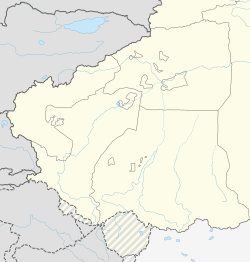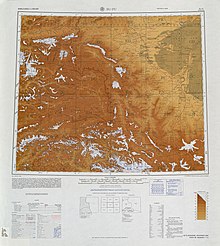| Dafdar
达布达尔乡 (Chinese) دەفتەر يېزىسى (Uyghur) ذەۋذار دىيۇر (Sarikoli) | |
|---|---|
| Township | |
 Wakhis and Kyrgyz at Dafdar as photographed by Aurel Stein Wakhis and Kyrgyz at Dafdar as photographed by Aurel Stein | |
 | |
| Coordinates: 37°20′34″N 75°24′23″E / 37.3427806°N 75.4063098°E / 37.3427806; 75.4063098 | |
| Country | People's Republic of China |
| Province | Xinjiang |
| Prefecture | Kashgar Prefecture |
| County | Tashkurgan Tajik Autonomous County |
| Area | |
| • Total | 11,400 km (4,400 sq mi) |
| Elevation | 3,700 m (12,100 ft) |
| Population | |
| • Total | 2,718 |
| • Density | 0.24/km (0.62/sq mi) |
| Ethnic groups | |
| • Major ethnic groups | Chinese Tajiks, Kyrgyz |
| Time zone | UTC+8 (China Standard Time) |
| Dafdar | |||||||||
|---|---|---|---|---|---|---|---|---|---|
| Chinese name | |||||||||
| Simplified Chinese | 达布达尔乡 | ||||||||
| Traditional Chinese | 達布達爾鄉 | ||||||||
| Hanyu Pinyin | Dábùdá'ěr Xiāng | ||||||||
| |||||||||
| Uyghur name | |||||||||
| Uyghur | دەفتەر يېزىسى | ||||||||
| |||||||||
| Sarikoli name | |||||||||
| Sarikoli | ذەۋذار دىيۇر [ðavðɔr diyur] | ||||||||
Dafdar, also spelled Daftar, is a township in the Taghdumbash Pamir located in Tashkurgan Tajik Autonomous County, Kashgar Prefecture, Xinjiang Uyghur Autonomous Region, China. The township is located near the China–Pakistan border. The southern part of the township is located in the Trans-Karakoram Tract claimed by India.
Name
Dafdar means "door" or "gateway" in the Sarikoli language, spoken by Chinese Tajiks.
History

The area has been used for grazing by various pastoral people in the region for centuries.
During the Qing dynasty, the Chinese claimed suzerainty over the area but permitted the Mir of Hunza to administer the region in return for a tribute. According to British colonial sources, this arrangement started during early Ayosh dynasty of Mir of Hunza, as the Mir conquered the Kirghiz nomads of Taghdumbash Pamir. The Mir erected a cairn in the village to evidence his control. The tribute system continued up until 1937.
In the 1875, British explorers recorded that Dafdar did not have a permanent settlement, but that it was used a caravan camp on the route between Tashkurgan and Hunza Valley. In the early 1900s, a group of Wakhi settled here with the consent of the Chinese authority.
In March 1950, Dafdar Township was established.
In 1959, Dafdar Township became a commune.
In 1966, Dafdar Commune was renamed Xianfeng Commune ('pioneer commune', 先锋公社).
In 1975 in the closing days of the Cultural Revolution, the original name was restored.
In February 1985, Dafdar Commune was made a township.
Emerald deposits were discovered in Dafdar in 2003. These emeralds show similar chemical fingerprints to Afghan emeralds from Panjshir Valley.
Geography
K2, the second highest mountain on Earth, is located in the Trans-Karakoram Tract on the China-Pakistan border in Dafdar.
Dafdar village lies at an altitude of 3,400 m above sea level, just to the east of the Karakoram Highway.
Administrative divisions
As of 2019, the township included five villages (Mandarin Chinese pinyin-derived names):
- Dafdar (达布达尔村), Bayik (Atejiayili 阿特加依里村), Raskam (Resikamu 热斯喀木村 / 热斯卡木村), Bositeduokete (波斯特多克特村), Khunjerab (红其拉甫村)
Demographics
| Year | Pop. | ±% p.a. |
|---|---|---|
| 2000 | 3,123 | — |
| 2010 | 2,718 | −1.38% |
In 1997, 89.6% of the population of the township was Chinese Tajik and 10.3% of the population was Kyrgyz.
It is inhabited by Wakhis.
As of the 2000s, there was one mosque in the township and twelve religious professionals.
Transportation
See also
- Shaksgam River
- Chalachigu Valley
- Trans-Karakoram Tract
- Yinsugaiti Glacier
- Sarpo Laggo Glacier
- List of township-level divisions of Xinjiang
Notes
References
- ^ 达布达尔乡. 中国·新疆塔什库尔干塔吉克自治县党政信息网 (in Simplified Chinese). 20 February 2009. Archived from the original on 22 August 2012. Retrieved 23 April 2020 – via Internet Archive.
达布达尔乡地处塔什库尔干塔吉克自治县南部喀喇昆仑山北麓,地势由南向北倾斜,东靠马尔洋乡,西北连塔什库尔干乡,东南接叶城县,南与巴基斯坦交界。总面积1.14万平方公里。海拔高度3700米。
- ^ 1997年塔什库尔干县行政区划. XZQH.org. 18 November 2011. Retrieved 22 April 2020.
达布达尔乡 地处喀喇昆仑山北麓,与巴基斯坦接壤。位于县城南49.5千米。314国道过境。塔什库尔干河由南向北流过。面积1.1万平方千米,人口0.2万,其中塔吉克族占89.6%,柯尔克孜族占10.3%,辖达布达尔、阿特加依里、帕克、热斯卡木4个行政村。境内有世界著名第二高峰乔戈里峰。
- ^ 塔什库尔干县历史沿革. XZQH.org (in Simplified Chinese). 14 November 2014. Retrieved 22 April 2020.
2000年第五次人口普查,塔什库尔干塔吉克自治县常住总人口30454人,其中:{...}达布达尔乡3123人、{...}2010年第六次人口普查,塔什库尔干塔吉克自治县常住总人口37843人,其中:{...}达布达尔乡2718人,{...}
- Xie Yuzhong 解玉忠 (2003). 地名中的新疆 (in Simplified Chinese). Ürümqi: 新疆人民出版社. pp. 235–236. ISBN 7-228-08004-1.
- huaxia, ed. (5 January 2020). "Xinhua selects China pictures of the year 2019". Xinhua News Agency. Archived from the original on April 21, 2020. Retrieved 22 April 2020.
Medical staff make a house call at a relocation community in Daftar Township of Taxkorgan Tajik Autonomous County in northwest China's Xinjiang Uygur Autonomous Region, July 7, 2019.
- ^ Complete Atlas Of The World (3 ed.). Penguin Random House. 2016. p. 238 – via Internet Archive.
- United States Board on Geographic Names: Gazetteer No. 22 Mainland China. Vol. 1 (2 ed.). United States Board on Geographic Names. September 1968. p. 270 – via Google Books.
DEFDAR SEE TA-FU-TAI-ERH PPL 37 20 N 75 25 E 44044
- ^ Kreutzmann, Hermann (2003). "Ethnic minorities and marginality in the Pamirian Knot: survival of Wakhi and Kirghiz in a harsh environment and global contexts". The Geographical Journal. 169 (3): 215–235. doi:10.1111/1475-4959.00086. ISSN 0016-7398.
All three groups traditionally move their flocks within the Taghdumbash Pamir and have been tributary to the Mir of Hunza who exercised control over these pastures until 1937. While the Kirghiz lived at higher elevations, the Sariqoli approached this area from the northern low-lying villages. The Wakhi, who were stranded as refugees from Afghanistan about a century ago, founded the settlement of Dafdar at 3400 m.a.s.l. in the heart of the Taghdumbash Pamir with the consent of the Chinese authorities (Kreutzmann 1996).
- ^ Christopher Snedden (2015). Understanding Kashmir and Kashmiris. Oxford University Press. p. 119. ISBN 978-1-84904-342-7.
For 200 years, the Mir of Hunza had paid tribute annually to officials of China's Qing/Manchu dynasty located in Kashgar. .. the Mir may have received tribute from a lesser ruler in the Taghdumbash Pamir north of Hunza. Although the Mir of Hunza eventually accepted Dogra suzerainty, the British only forced him to end his tributary relationship with China in 1937
- Gazetteer of Gilgit (2nd ed.). Simla: Government of India Press. 1927. p. 85.
In former days Salim Khan, son of Ayasho and ruler of Hunza, marched against the Kirghiz nomads of the Taghdumash Pamir, and in the battle that ensued utterly routed them. In celebration of his victory he erected a cairn of stones at Dafdar, and sent a trophy of Kirghiz heads as present to the Chinese, together with a message that Hunza territory extended as far as Dafdar. Although hitherto Humza had held no intercourse of any kind with the Chinese, the latter returned a present to Salim Khan for having conquered their enemies, and henceforward a custom of an annual interchange of presents between the Chinese and the people of Hunza has prevailed to this day. Hunza has also drawn a yearly tribute in the form of a grazing tax, from all, whether Kirghiz or Sarikuli, who graze in the Taghdumbash.
- Henry Walter Bellew (1875). The history of Káshgharia. Calcutta: Foreign Dept Press. p. 115.
Davdar, 4 tash. Across valley and amongst hills to camp ground. The first stage from Tashcorghan. No habitation.
- Kamoludin Abdullaev; Shahram Akbarzaheh (27 April 2010). Historical Dictionary of Tajikistan. Scarecrow Press. p. 345. ISBN 978-0-8108-7379-7.
Ethnically, the Tajiks of China form a collection of small East Iranian ethnic groups with the Vakhani (Wakhi) as a separate faction. With the permission of the Chinese authorities in the early 20th century, the Vakhanis founded their settlement of Dafdar, south of Tashkurgan.
- Schwarz, Dietmar; Pardieu, Vincent (Fall–Winter 2009). "Emeralds from the Silk Road Countries – A Comparison with Emeralds from Colombia". InColor. No. 12. pp. 38–43. ISSN 1558-934X.
emeralds from China were only discovered recently. It is possible, at least for the Davdar deposit, located on a major axis of the Silk Road, that it was already worked in the past. ... The arrival of good quality material from the Davdar deposit in 2003 created great expectations in the Asian and European markets. ... The emeralds from Davdar and Panjshir, however, show a nearly complete overlap.
- 2019年统计用区划代码和城乡划分代码:达布达尔乡 (in Simplified Chinese). National Bureau of Statistics of the People's Republic of China. 2019. Retrieved 22 April 2020.
统计用区划代码 城乡分类代码 名称 653131204200 210 达布达尔村委会 653131204201 220 阿特加依里村委会 653131204202 220 热斯喀木村委会 653131204203 210 波斯特多克特村委会 653131204204 220 红其拉甫村
- Wiener, Gerald; Han, Jianlin; Long, Huijun (June 2003). "Yak keeping in Western High Asia: Tajikistan, Afghanistan, Southern Xinjiang Pakistan, by Hermann Kreutzmann". The Yak (2nd ed.). Bangkok: Food and Agriculture Organization. ISBN 9251049653. Retrieved 13 January 2020.
Only the Wakhi founded their settlement of Dafdar (3 400 m) in the heart of the Taghdumbash Pamir, about a century ago, with the consent of the Chinese authorities.